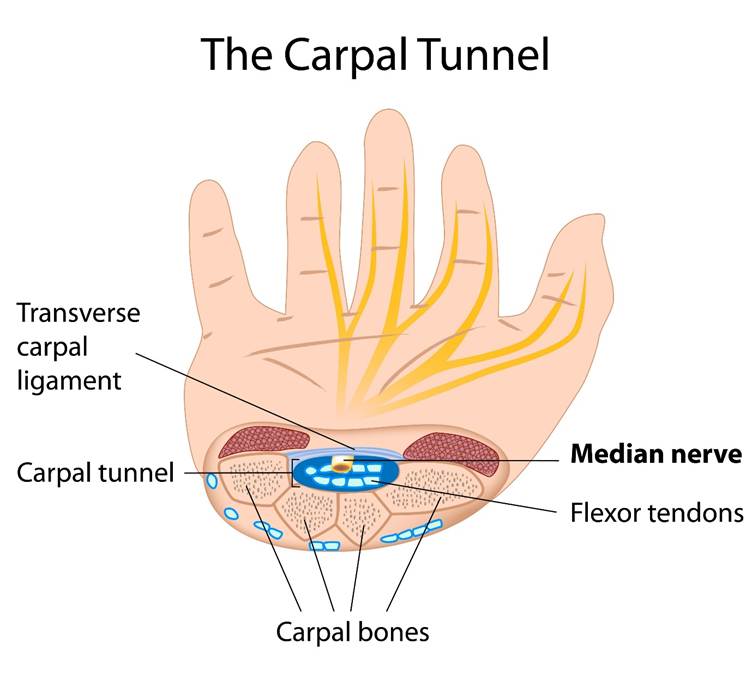Carpal Tunnel Syndrome (CTS) is a common condition that affects the hand and wrist, causing pain, numbness, tingling, and weakness. It develops when the median nerve—one of the major nerves to the hand—becomes compressed as it travels through the carpal tunnel, a narrow passageway in the wrist.
Often associated with repetitive hand movements and poor ergonomics, carpal tunnel syndrome can impact daily life significantly if left untreated.
Understanding the Carpal Tunnel Anatomy
The carpal tunnel is a narrow, rigid passageway made up of bones and ligaments at the base of the hand. The median nerve and tendons that control finger movement pass through this tunnel.
When the space within the tunnel becomes narrowed or the tissues surrounding the tendons swell, they can press against the median nerve, resulting in carpal tunnel syndrome.
Causes of Carpal Tunnel Syndrome
Several factors may contribute to the development of CTS:
- Repetitive Hand Movements
Frequent typing, assembly line work, or using tools that vibrate can irritate the tendons and compress the median nerve. - Wrist Positioning
Prolonged bending or extending the wrist can increase pressure inside the tunnel. - Inflammatory Conditions
Diseases like rheumatoid arthritis cause inflammation that can affect the carpal tunnel space. - Pregnancy and Hormonal Changes
Fluid retention during pregnancy may increase pressure within the tunnel. - Medical Conditions
Diabetes, hypothyroidism, and obesity are linked to a higher risk of CTS.
Symptoms of Carpal Tunnel Syndrome
Symptoms usually start gradually and often begin during the night or upon waking:
- Tingling or numbness in the thumb, index, middle, or ring fingers
- Pain radiating up the forearm or down to the fingers
- Weakness in the hand and difficulty holding objects
- Clumsiness or a tendency to drop things
As the condition progresses, symptoms may become constant and more severe.
Diagnosis of CTS
Doctors may use a combination of the following methods:
- Physical Examination
Checking for weakness or atrophy in the hand muscles - Tinel’s Sign or Phalen’s Test
Provocative maneuvers to reproduce symptoms - Nerve Conduction Studies (NCS)
Measure how well the median nerve transmits electrical signals - Electromyography (EMG)
Assesses muscle response to nerve stimulation
Treatment Options for Carpal Tunnel Syndrome
Non-Surgical Treatments
- Wrist Splints
Wearing a brace, especially at night, to keep the wrist in a neutral position - Activity Modification
Reducing repetitive tasks or improving hand ergonomics - Medications
NSAIDs or corticosteroid injections to reduce inflammation - Hand Therapy
Exercises to stretch and strengthen wrist and hand muscles
Surgical Treatment
If symptoms are severe or persistent, a carpal tunnel release surgery may be recommended. This procedure involves cutting the ligament pressing on the median nerve to relieve pressure and restore function.
Prevention Tips
- Maintain good ergonomics when typing or using tools
- Take frequent breaks during repetitive tasks
- Keep wrists in a neutral position during sleep and work
- Stretch and exercise hands and wrists regularly
- Use supportive braces if needed, especially for long durations of wrist activity
Conclusion
Carpal Tunnel Syndrome can be disruptive, but early diagnosis and proper treatment can relieve symptoms and prevent long-term damage. Whether you’re an office worker, musician, or someone who uses their hands frequently, being mindful of your hand and wrist health is essential.
If you notice symptoms like tingling or numbness in your hands, consult a healthcare provider to determine if you’re at risk for CTS and explore preventive or therapeutic strategies.
Disclaimer: This article is for informational purposes only and should not replace professional medical advice. Always consult a healthcare provider for accurate diagnosis and treatment.
